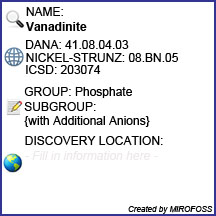

| Mineral Name | Vanadinite |
| First Discovered | 1801 |
| Nickel-Strunz Classification | 08.BN.05 |
| Dana Classification | 41.08.04.03 |
| ICSD | 203074 |
| Mineral Group | Phosphates |


| Cleavage | None |
| Colour(s) | Brown, Brownish yellow, Brownish red, Yellow, Colourless |
| Specific Gravity | 6.94 |
| Diaphaneity | Sub transparent to Opaque |
| Fracture | Brittle - Conchoidal - Very brittle fracture producing small, conchoidal fragments |
| Mohs Hardness | 3.5 to 4.0 |
| Luminescence | Non-fluorescent |
| Lustre | Adamantine |
| Streak | Brownish yellow |
| Habit(s) | Globular to Nodular to Prismatic |
| Radioactivity | Non-radioactive |
| Magnetism | Non-magnetic |

The following health hazards should be noted when handling vanadinite:
 |
BIOHAZARD Vanadinite contains the element lead which is known to cause long term health effects. |

The following image shows the Elemental breakdown of the mineral vanadinite along with the mineral crystal structure.


| Crystal System | Hexagonal |  |
| Class | Dipyramidal | |
| Axial Ratios | a : c = 1 : 0.711 | |
| Morphology | Well developed hexagonal prisms with smooth faces and sharp edges | |
| Optical Data Type | Uniaxial (-) | |
| Dichroism (e) | Light | |
| Dichroism (w) | Dark | |
| Pleochroism | Weak | |
| RL Values | nω = 2.416 nε = 2.350 |  |
| Max Birefringence | δ = 0.066 (See colour chart at right) | |
| Surface Relief | Very high | |
| Comments | Visible in tinted material in transmitted light | |

Vanadinite can be referenced in certain current and historical texts under the following three names:
The mineral erythrite can be translated into the following select languages:
| Arabic | فانادينيت | Bulgarian | Chinese (Sim) | 钒铅矿 | |
| Croatian | Czech | Danish | |||
| Dutch | Vanadiniet | Esperanto | Estonian | ||
| Finnish | Vanadiniitti | French | Plomb brun | German | Vanadinit |
| Greek | Βαναδινίτης | Hebrew | Hungarian | ||
| Italian | Vanadinite | Japanese | バナヂンナイと | Korean | 바낟인아이드 |
| Latin | Lithuanian | Vanadinitas | Norwegian | ||
| Persian | Polish | Wanadynit | Portuguese | Vanadinita | |
| Romanian | Vanadinit | Russian | Ванадинит | Slovak | |
| Spanish | Vanadinita | Swedish | Vanadinit | Tagalog | |
| Turkish | Ukrainian | Ванадиніт | Vietnamese |

Vanadinite can be found in a few places around the world. The map below shows major documented concentrations of vanadinite:


 |
The MIROFOSS database offers free printable geological identification tags for personal and non-profit use. These tags can be used to properly identify mineral samples in your collection. -Click here- to download a full size jpeg image for a vanadinite identification tag; which can be printed on paper or used with a plastic laser printer. |
 |
What's this? What can I do with it? |

| Crystallography | Laufek, F., Skála, R., Haloda, J., Cisařová, I. (2006): Crystal structure of vanadinite: Refinement of anisotropic displacement parameters. Journal of the Czech Geological Society, 51(3-4), 271-275. |
| Crystallography | Baker, W. E. (1966): An X-ray diffraction study of synthetic members of the pyromorphite series. American Mineralogist 51, 1712-1721. |
| History | Anthony, J.W., Bideaux, R.A., Bladh, K.W., and Nichols, M.C. (2000) Handbook of Mineralogy, Volume IV. Arsenates, Phosphates, Vanadates. Mineral Data Publishing, Tucson, AZ, 680pp.: 616. |
| History | Canadian Mineralogist (1989): 27: 189. |
| Geograpcial Data | Mindat.org. Retrieved on 2012-05-07 |
| Physical Identification | Webmineral.com. Retrieved on 2012-05-07 |
| May 07, 2012 | The last time this page was updated |
| ©2017 MIROFOSS™ Foundation | |
 |